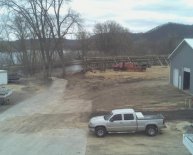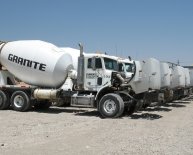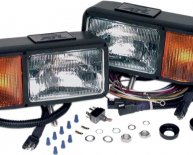
Concrete trucks in Action
Contrary to popular belief, concrete and cement are not the same thing; cement is actually just a component of concrete. Concrete is made up of three basic components: water, aggregate (rock, sand, or gravel) and Portland cement. Cement, usually in powder form, acts as a binding agent when mixed with water and aggregates. This combination, or concrete mix, will be poured and harden into the durable material with which we are all familiar.
Components of Concrete
There are three basic ingredients in the concrete mix:
1. Portland Cement
2. Water
3. Aggregates (Rock and Sand)
Portland Cement - The cement and water form a paste that coats the aggregate and sand in the mix. The paste hardens and binds the aggregate and sand together.
Water - Water is needed to chemically react with the cement (hydration) and too provide workability with the concrete. The amount of water in the mix in pounds compared with the amount of cement is called the water/cement ratio. The lower the w/c ratio, the stronger the concrete (higher strength, less permeability).
Aggregates - Sand is the fine aggregate. Gravel or crushed stone is the coarse aggregate in most mixes.
Tips on Ordering Concrete
Ordering concrete is easy, even if you are a first time caller. Our dispatchers are trained to guide you through every step of the way. Here are a few important tips to remember to help in placing a successful order:
1) Give the day you are going to need the concrete.
2) Give the time you want the concrete.
3) Give the address you want the concrete delivered. Timely deliveries are the key to our business. We appreciate all the information that you can provide to guarantee excellent service.
4) Give a contact number where the concrete dispatcher can call you the day of the delivery.
5) Give the strength and size stone or mix design you are ordering.
6) Give the total number of yards needed for your project. If you do not know the concrete dispatcher will be more than happy to calculate it for you or a concrete calulator is provided on the previous webpage. A good rule of thumb is take your calculation and add 4% to 10% to the total to account for waste, spillage, over-excavation, settlement, spreading of forms, loss of entrained air or any other changes in volume. Concrete can be ordered in 1/2 yard increments.
7) If you have multiple concrete loads let the concrete dispatcher know the spacing you want on the trucks. For example, "I need the trucks 30 minutes apart."
8) Inform the concrete dispatcher on what you are pouring (Driveway, Garage, Sidewalk, Back Patio, Pool Collar, Curb, Basement Floor, etc.) and how you are going to unload the concrete mixer. (Truck can directly pour from chute, wheelbarrow, concrete pump, crane bucket, etc.)
Confirm your order the day before you want the concrete or even ninety minutes before your scheduled delivery time to insure proper accuracy.
Desired Properties of Concrete
1) The concrete mix is workable. It can be placed and consolidated properly by yourself or your workmen.
2) Desired qualities of the hardened concrete are met: for example, resistance to freezing and thawing and deicing chemicals, watertightness (low permeability), wear resistance, and strength. Know what you are trying to achieve with the concrete.
3) Economy. Since the quality depends mainly on the water to cement ratio, the water requirement should be minimized to reduce the cement requirement (and thus reduce the cost).
Take these steps to reduce the water and cement requirements:
use the stiffest mix possible.
use the largest size aggregate practical for the job.
use the optimum ratio of fine to coarse aggregate.
Discuss how to achieve your goals for the concrete with one of Action Supply's concrete dispatchers.
Concrete Reinforement
Fibers can be added to the concrete mix in lieu of welded wire mesh.
The problem with welded wire mesh is that it often ends up on the ground from being stepped on as the concrete is being placed. (particularly if no support blocks are used). Another problem is that mesh does not prevent or minimize cracking-it simply holds cracks that have already occurred together.
If you could look into a section of concrete poured with fibers you would see millions of fibers distributed in all directions throughout the concrete mix. As micro cracks begin to appear due to shrinkage as water evaporates from the concrete (plastic shrinkage), the cracks intersect with the fibers which block their growth and provide higher tensile strength capacity at this crucial time.
Admixtures
Admixtures are materials other than cement, sand, aggregates, and water that are added to concrete immediately before or during mixing to modify the properties of hardened concrete or to ensure the quality of concrete during mixing, transporting, placing, and curing. Admixtures can be used to provide greater plasticity, workability and earlier levels of strength than from normal concrete.
Accelerating Admixture - Accelerators are added to concrete to reduce setting time of the concrete and to accelerate early strength. The amount of reduction in setting time varies depending on the amount of accelerator used.
Retarding Admixtures - Are often used in hot weather conditions to delay setting time. They are also used to delay set of more difficult jobs or for special finishing operations like exposing aggregate. Many retarders also act as a water reducer.
Air Entraining Admixtures - Must be used whenever concrete is exposed to freezing and thawing, and to deicing salts. Air entraining agents entrains microscopic air bubbles in the concrete: when the hardened concrete freezes, the frozen water inside the concrete expands into these air bubbles instead of damaging the concrete.
Air entrainment improves concrete workability
Air entrainment improves durability
Air entrainment produces a more workable mix
Water Reducing Admixtures - Reduces the amount of water needed in the concrete mix. The water cement ratio will be lower and the strength will be greater. Most low range water reducers reduce the water needed in the mix by 5%-10%. High range water reducers reduce the mix water needed by 12% to 30% but are very expensive and rarely used in residential work.
Super P - Super P stands for super plasticizers also known as high range water reducers. Its a chemical admixture added to the concrete to make the concrete extremely workable increasing the flowability of the concrete without reducing the concretes strength. The effects of super P are only temporary (15-60minutes) and is generally added on the job by the concrete mixer driver or quality control representative from the company. Super P can reduce the mix water needed by 12% to 30%.

















